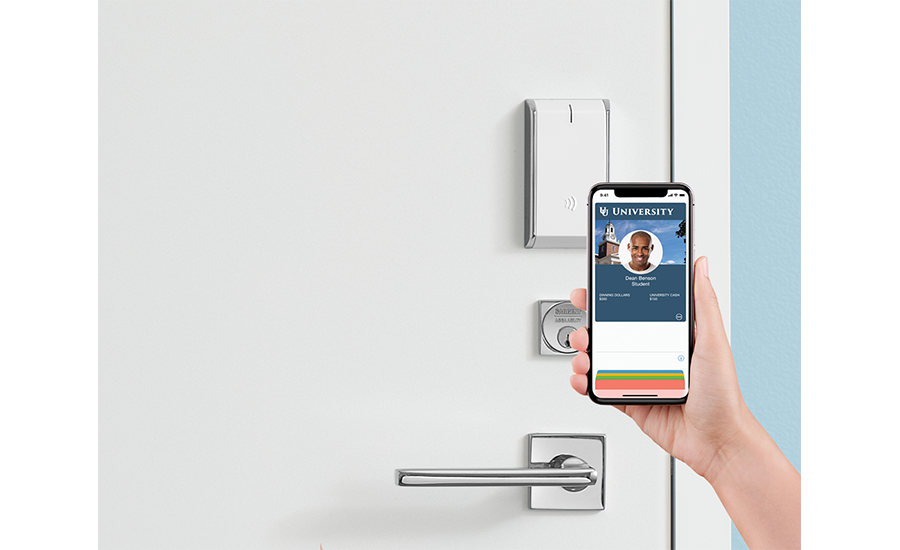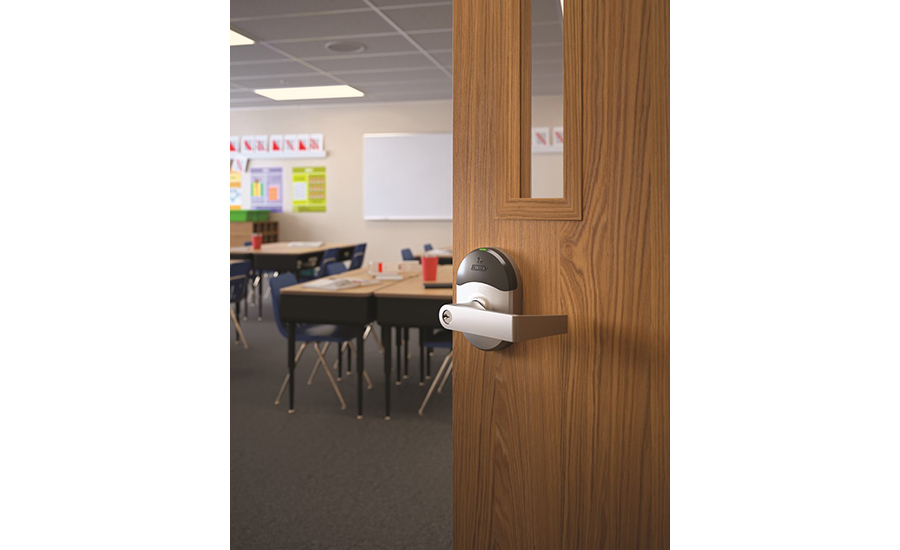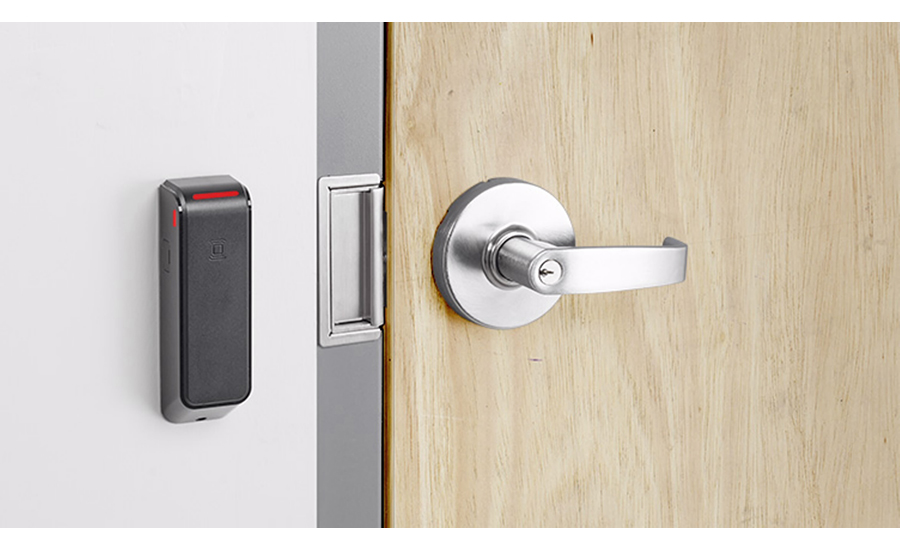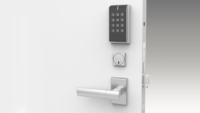Mobile credentials, touchless opening solutions, electronic lock advances and increased customer demand for additional electronic access control (EAC) devices are just a few of the trends driving the security locks and door hardware market right now.
“The pandemic and associated global economic impact were major disrupters that created new trends, while simultaneously accelerating others,” says Brad Sweet, commercial marketing leader, Allegion, Carmel, Ind. “What surprised me is the pace at which change related to commercial and institutional buildings occurred.”
Much of this demand is coming from K-12 school districts as they began evaluating security best practices and prompting upgrades, Sweet adds. During the pandemic, “Schools across the country began adopting electronic locks and exit devices that can be monitored or locked down as a part of a complete access control,” he says.

Mobile credentials for access are especially hot on college campuses because students use their mobile phones for vending machines, dining, book and supply purchases and more. // IMAGE COURTESY OF ASSA ABLOY
However, schools aren’t the only customers adopting EAC. “Mobile credentials were widely adopted in higher education and commercial settings as well,” Sweet adds. “This comes as no surprise as expanded support for wallet-based solutions from Apple and Google helped drive this trend.”
Over the past year, the most surprising change in the locks and hardware market has been the continued effects of the pandemic shutdown, including ongoing supply chain and economic issues that are affecting the labor market, raw goods costs and new construction projects, says David Price, vice president, communications and business development at Camden Door Controls, Mississauga, Ontario.
And while electronic locking solutions may be growing in popularity, so is the convergence of electronic and mechanical door hardware and the need to deliver open solutions for customers, says Bret Holbrook, senior vice president, Americas AHS and ACS channel sales at dormakaba, Indianapolis. “Going forward, the security industry will be even more digitally and mobile dependent, but mechanical locks will remain in use, particularly in legacy installations that may not have the budget or security impetus to change and for specific access points,” he says. “The good news is that they can complement each other to meet the security needs of a property and enhance the resident or guest experience.”
Big Demand for EAC
Increasing customer demand for a broader range of EAC products for both new construction and renovation retrofits continues to grow, says Peter Boriskin, chief technology officer at ASSA ABLOY Opening Solutions Americas, New Haven, Conn. “EAC provides the balance of security and convenience that customers need, and now they expect that capability to exist wherever they want to control access or audit use,” he says. “The ability to issue and customize credentials quickly and remotely makes it fast and easy to authorize access to specific users and places.”
What’s more, EAC systems capture data that’s useful for the customer, with significant progress being made by pairing building management and access control systems. “Depending on the number of people that an access control system ‘knows’ are in a building space, for example, the more data it can feed the building’s management system to regulate temperature and lighting,” Boriskin adds.
This knowledge helps management make adjustments such as changing airflow in a particular area of an office for better filtration or adding more air conditioning as more people occupy a space. “Not only can this promote greater comfort and healthier, more productive surroundings, but it also creates opportunities for greater energy efficiency,” which is especially important as flexible workspaces keep evolving, Boriskin says.
Topping the list of customer demands are e-locks as part of an overall security ecosystem, Sweet points out. Examples include using e-locks and software solutions to help facilities manage visitor arrival times at healthcare waiting rooms, multi-family package delivery and other use cases across industries.
Tech advances are also making it easier for technicians to install e-lock systems, with more low-voltage system contractors installing electric strikes every year, Price says. “There was a time when almost every system installer would subcontract a locksmith to install their strikes,” he says. “‘Universal’ strike designs, multi-faceplate packages and marketing jigs in the box make it easier for installers to install strikes themselves.”
Beyond e-locks alone, Price is also seeing more interest in battery-powered electric strikes, although he says the jury is still out on whether short battery life and ongoing maintenance costs will outweigh the potential advantage of a low-cost installation.
The Impact of Mobile
One of the biggest changes in locks and hardware has been the advance of access controlled locksets using cell phone credentials and cloud-based security access control, says William J. Sporre, senior vice president, Marks USA. “The cell phone is so widely used as the credential and the use of the cloud base to transfer data to the locks, so there is no need for gateways or wiring in facilities,” which adds little or no infrastructure costs, he says.
“Credentials stored on individuals’ phones and expressed as a mobile credential will continue to make a splash because they work with existing paradigms for people’s lives,” says Sweet of Allegion. Unlike biometrics provided by a separate system, building or enterprise, biometrics that secure an individual’s cell phone build on a trusted relationship and understanding of how the information is stored because it’s something that most people have already interacted with, he says. Additionally, the fast upgrade cycle of cell phones supports the rapid pace of change, especially compared with building infrastructure that’s expected to operate for years, he points out.

Many K-12 school districts began adopting electronic locks and exit devices that can be monitored or locked down. // IMAGE COURTESY OF ALLEGION
Mobile credentials for access are especially hot on college campuses because students use their mobile phones for just about every kind of transition, such as vending machines, dining, book and supply purchases and more, Boriskin says. “Devices integrated with the latest BLE [Bluetooth Low Energy] and NFC [near field communications] technologies have helped expand these capabilities,” he says. “Today, students expect their schools to incorporate mobile wallets and similar apps campus-wide. Some even make it a consideration when decided where to apply.”
Mobile devices are also far less likely to be forgotten, misplaced or lost, compared with card credentials, meaning fewer requests for card replacements and a much lower likelihood that credentials will fall into the wrong hands, he adds. “This adds up to creating a more secure campus, whether it’s providing a student with personalized credential to access a residence hall suite or lab, or for broader entry to classrooms and special events.”
Touchless Solutions on the Rise
Although low-touch and touchless entry solutions were already on the rise before the pandemic, COVID-19 increased interest, and now they’re in higher demand than ever before, Boriskin says. “Low-touch activation just takes an easy bump of a button with a forearm, elbow or hip, or a press of a foot pedal,” he says. “With fully touchless technology, a sensor automatically opens the door on approach. For restricted environments, a quick scan of a badge, card or fob credentials activates the sensor. Mobile access is also rapidly on the rise here, too.”
While touchless access is especially important in healthcare settings, other customers became more interested during the pandemic. “The fewer touchpoints coming through a doorway, the lower the chance of transmitting disease,” Boriskin says. “While this may not help as much with airborne viruses like COVID-19, the benefits are still great for reducing the spread of germs and infections in general, which is on people’s minds more than ever.”
Additionally, mobile credentials, visitor management software and automated doors are all evolving and leveraging touchless enhancements, adds Sweet of Allegion. “There’s a huge demand for interoperability and companies are following suit,” he says. “I’ve noticed a shift to interoperable solutions in the security space that provide more flexibility for the end user.”
Interoperability and “future-proofing” a locks and hardware investment is a requirement for many customers; and for EAC systems, this means solutions with open integration standards that give customers the option to migrate intelligent endpoints across multiple systems, says Holbrook of dormakaba. “These integrations can create new value add to the customers by solving pain points they experience on a daily basis,” he says. “The integrations and opportunity to solve these new pain points are not possible without an open solution.”

Electronic access control (EAC) enables customers to issue and customize credentials quickly and remotely, making it fast and easy to authorize access to specific users and places. // IMAGE COURTESY OF ASSA ABLOY
Moreover, open solutions are contingent on strong partnerships within the security industry, Holbrook adds. He advises integrators to choose electronic security solutions with open standards and to “work with suppliers whose products deliver a path to utilize and work with systems in the future, to ensure they are ready for the rapidly changing technology environment.”
And speaking of partnerships, this is something that integrators should pursue with their manufacturer partners to stay abreast of the latest developments in locks and hardware technology. “We’re constantly pushing for innovation, so it’s important to stay informed on the latest developments in door security and related door hardware,” Boriskin says. “Opportunity abounds in access control and the many other areas that a manufacturer like ASSA ABLOY offers, including extensive hardware solutions for glass installations, specialty doors, decorative options, and much more. Be sure to explore the possibilities that can help you continue to grow your business.”
Finally, “Be prepared to adapt to a changing marketplace,” Holbrook says. “This includes going beyond the norms of working with mechanical hardware, electronic access control, alarms and video systems. Security solutions now include low-energy operators, touch-free access devices, and electromechanical door hardware that work in conjunction with these systems. Invest in training — much of it free from manufacturers — to maximize expertise and advance business opportunities.”






